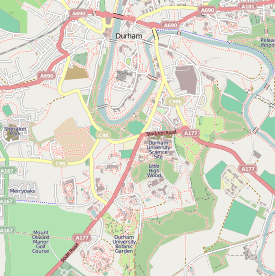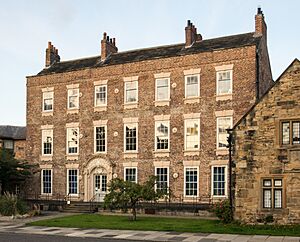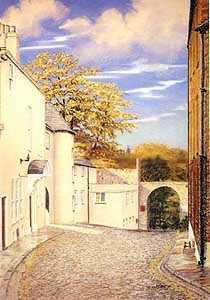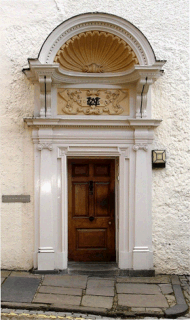St Cuthbert's Society, Durham facts for kids
Quick facts for kids St Cuthbert's Society |
||||||||||
|---|---|---|---|---|---|---|---|---|---|---|
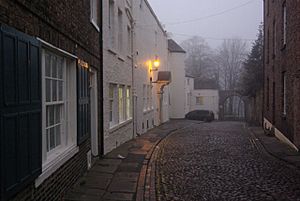 |
||||||||||
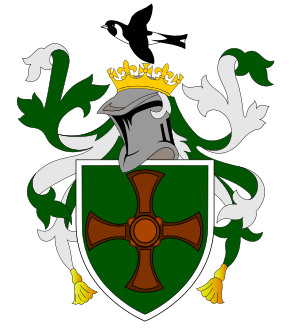
Arms of St Cuthbert's Society
Blazon: Vert, a representation of St. Cuthbert's cross proper; a bordure argent. |
||||||||||
|
|
||||||||||
| University | University of Durham | |||||||||
| Coordinates | 54°46′15″N 01°34′38″W / 54.77083°N 1.57722°W | |||||||||
| Latin name | Societas Sancti Cuthberti | |||||||||
| Motto | Latin: Gratia gratiam parit | |||||||||
| Motto in English | Friendship begets friendship | |||||||||
| Established | 25 October 1888 | |||||||||
| Named for | Cuthbert of Lindisfarne | |||||||||
| Principal | Professor Tammi Walker | |||||||||
| Undergraduates | 1500 | |||||||||
| Postgraduates | 106 | |||||||||
| Website |
|
|||||||||
| Map | ||||||||||
St Cuthbert's Society, often called Cuth's, is a special college at Durham University. It started in 1888 for students who weren't part of the other colleges yet. Cuth's is a "Bailey college," meaning it's located on Durham's peninsula, right by the River Wear. It also has other places for students to live nearby.
St Cuthbert's is still called a 'society', but how it works has changed over time. It was unique because students themselves helped create it as a common room. Other societies like St Aidan's and the Graduate Society followed this idea. Cuth's is known for having many local students and older students. It's the only college that offers different types of student housing: some with meals included, some with partial meals, and some where students cook for themselves.
Contents
Exploring the History of St Cuthbert's
How St Cuthbert's Began
In 1871, Durham University started letting "unattached" students join to increase student numbers. These students lived in rented rooms, not in colleges. They still had to follow university rules, like going to morning prayer and wearing gowns. But they had more privacy, which other students sometimes wished for.
These unattached students were usually at least 23 years old and often married. They didn't join in much social or sports activities. They didn't have their own clubs or a common room to meet.
Growing Strong: 1888 to 1918
After a few tries, the unattached students finally came together in October 1888. They held a successful meeting and chose a committee. They decided to have regular meetings and plan events, like debates every other week. A staff member named Hastings Rashdall was very excited about this. He thought students spent too much time studying and not enough time socializing. A few weeks later, the group became "St Cuthbert's Society," named after the famous saint.
In 1893, the society got its own common room in Cosin's Hall. This became their main home for the next 50 years. Even though it was like a private student club, the university started treating it like a college. St Cuthbert's Society began to have its own identity through sports. The university even gave them facilities like the common room and a boat house. By the late 1890s, people were talking about St Cuthbert's Society as if it were a real college. From 1894, all unattached students automatically became members.
Around the time of Queen Victoria's death, the students' views started to change. At first, they supported traditional ideas, but then more modern ideas appeared. Over time, the students' opinions often matched what was happening in the country. Many "Cuthbert's men" became Liberals.
In 1910, the university decided to call unattached students living in Durham "non-collegiate" students. This helped tell them apart from other students studying from outside the university. This meant the non-collegiate group and St Cuthbert's Society became the same. When World War I started, the society first tried to ignore it. But in 1916, a law made all unmarried men aged 18-41 join the army. By March, 13 society members were serving, and two sadly lost their lives. St Cuthbert's Society had fewer losses than some other places. This was because many of its members were chaplains, who often served in safer roles.
The Society grew until World War II, when student numbers dropped. It was restarted in 1945 by veterans returning from the war. In 1951, the Society moved to the South Bailey and started offering housing. They also created the role of Principal. The first Principal was Clifford Leech, a famous expert on Jacobean literature. His picture hangs in the college hall. Today, the Principal manages everything at the Society. The Society has university staff, student groups, alumni, and fellows.
Over the years, the Society has grown a lot. It now has many buildings for housing on the Bailey and elsewhere. In 1969, it was the first college in Durham to welcome both male and female students. In 2006, 'Brooks House' was built. This allowed all first-year students to live in college for the first time.
Fun Traditions at St Cuthbert's
The Society remembers its patron, St. Cuthbert, every year with "The Feast." This is a traditional dinner held around March 20th, his special day.
Another yearly event is Cuth's Day. This is a day of fun activities held on, off, and in the River Wear. The river flows around the area where the Society is located.
Students who helped restart the Society after the war have a reunion every September. This weekend also includes a meeting for the St Cuthbert's Association, which is the group for former students. The Society also remembers its founders at a special dinner called the Founders' Formal. Past Presidents also have their own formal dinner.
St Cuthbert's has a friendly rivalry with Hatfield College nearby. This shows up in sports and other activities. There's a funny story from the 1960s. Some Cuth's students supposedly took a lion statue from Hatfield and painted it like a tiger to hide it!
Understanding the Coat of Arms
The original cross of St. Cuthbert was found in his grave in 1827. It is now kept in the cathedral treasury. The Society's motto, gratia gratiam parit, means ‘friendship begets friendship’ or ‘kindness begets kindness’. The full coat of arms also includes an eider duck. This is because St Cuthbert protected these birds on the Farne Islands. He created what might have been the first bird protection laws ever! Because of this, eider ducks have long been called 'cuddy ducks' (Cuthbert's ducks) in the local dialect.
Where Students Live: Buildings and Accommodation
The Bailey Buildings
The main buildings of St Cuthbert's Society are at the end of the Bailey. This is an old street with other colleges. The Bailey has five historic buildings, many with shared rooms. These include House 12 (the main office), House 8 (the biggest), House 13 and Wendy House (which share a large garden), and Houses 26 and 27 on North Bailey.
Students living here can hear the bells of the Cathedral nearby. There's also a friendly rivalry with Hatfield College and St John's College next door.
House 12: The Main Hub
House 12 is the main office for the Society. It has the Bailey Bar, the JCR (Junior Common Room), and a dining room that seats 150 people for dinners. It also has a garden. A few undergraduate students live here, including the bar steward, who lives above the bar. This building is very old, from the 1600s, and is a Grade II* listed building, meaning it's very important historically.
House 8: Living and Learning
House 8 has most of the student housing on the Bailey. It also has a library with computers and a meeting room for all members. There's a gym, a study room, and two big gardens that go down to the River Wear. The garden also has a Grade I listed wall, which is very old and important. This building was built in the late 1700s and is a Grade II listed building.
The JCR president gets to live in a flat inside House 8 every year. This is because their role is full-time. Their flat is right above the Society's library.
House 13 and Wendy House
House 13 offers more student housing on the Bailey. It doesn't have shared facilities for people not living there. It's an early 1700s Grade II listed building. Wendy House is in the garden of House 13 and usually houses five students. The garden looks out over the Society's main buildings and is next to one of the cathedral's gardens. It also borders The Chorister School.
Houses 26 and 27
Houses 26 and 27 are on North Bailey and offer the rest of the housing. They are only for living and have no shared facilities. These buildings are from the mid-1700s. They are in a good spot further up the Bailey but still very close to the main office.
Parsons Field: Modern Living
Most of the Society's student housing is at Parsons Field, in Old Elvet. This area has four buildings. One, Brooks House, has rooms with private bathrooms. The others, Refounders House, Parsons Field Court, and Fonteyn Court, have standard single rooms. Brooks House is usually for returning students, while the other buildings at Parsons Field are mainly for first-year students.
St Cuthbert's Society offers different meal plans for students. Parsons Field also has another bar, a gym, a computer room, and a music room.
Student Life and Activities
The Society has over 40 sports teams and clubs! These include a rugby team, a hockey team, a boat club, a running club, a drama society, an art society, a big band, and a choir.
Boat Club: Rowing on the River
The St Cuthbert's Society Boat Club started in 1893, five years after the Society itself. It offers training and facilities for rowers of all skill levels. It's one of the oldest and most respected student clubs at the university.
Running Club: Hitting the Trails
The running club started in 2016 and is one of the most successful sports teams in the college. The club also gives personalized coaching plans. They have very popular social events that often attract more than 50 members.
Leaders of St Cuthbert's Society
- Clifford Leech (1948–52)
- E. de Groot, (1952–54)
- W. A. Whitehouse, (1954–61)
- J. J. Grant, (1961–63)
- J. L. Brooks, (1963–85)
- J. D. Norton, (1985–90)
- S. Stoker, (1990–2000)
- B. Robertson, (2000–01)
- D. Robson, (2001–03)
- Roy Boyne, (2003–08)
- Graham Towl, (2008-2011)
- Amanda Broderick, (2011)
- Sharon Richardson, (2011–12)
- Elizabeth Archibald, (2012–2021)
- Tammi Walker, (2021–present)
Famous People from St Cuthbert's
Academics and Scholars
- Michael Aris, a leading expert on Bhutanese, Tibetan, and Himalayan culture. He was married to the Burmese politician Aung San Suu Kyi.
- Leo Blair, a lawyer and lecturer, and father of former UK Prime Minister, Tony Blair.
- John Joseph Wilkes, a respected archaeologist and professor.
Arts and Literature
- Russell Ash, an author.
- Andrew Buchan, an actor.
- Rod Clements, a musician.
- Justin Hill, an author.
- Anthony Payne, a composer.
- Charlotte Riley, an actress.
- Dan van der Vat, a journalist and author.
- Matt Barber, an actor.
- Tom Rosenthal, a musician.
Broadcasting and Media
- Alastair Fothergill, a TV Producer known for the Blue Planet series.
- Nina Hossain, a broadcast journalist.
- Kate Silverton, a broadcast journalist.
Religion
- David Williams Bentley, a Bishop of Barbados.
- William Nigel Stock, a Bishop at Lambeth.
Business Leaders
- Nick Scheele, a former President and Chief Operating Officer of Ford Motor Company.
Sports Stars
- Michael Knighton, a former Chairman of Carlisle United F.C..
- Oliver Gill, a footballer for Manchester United Football Club.


